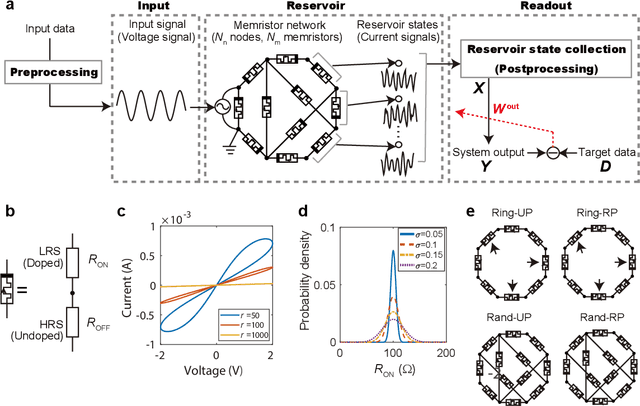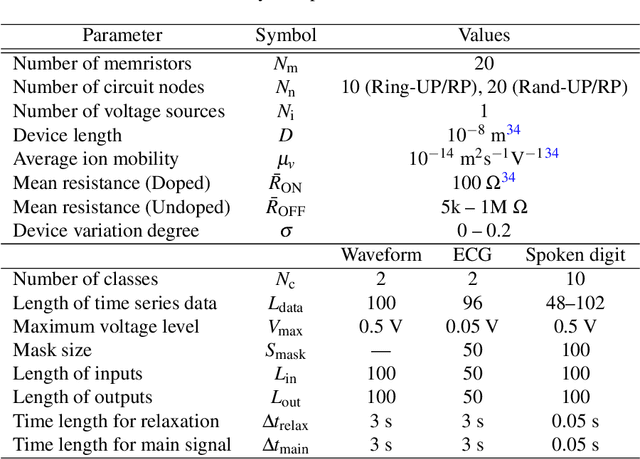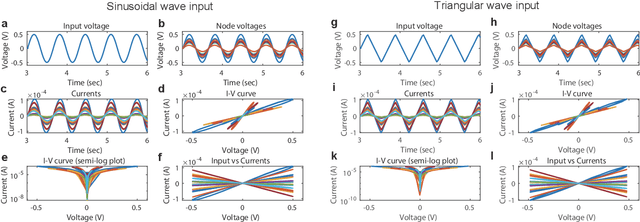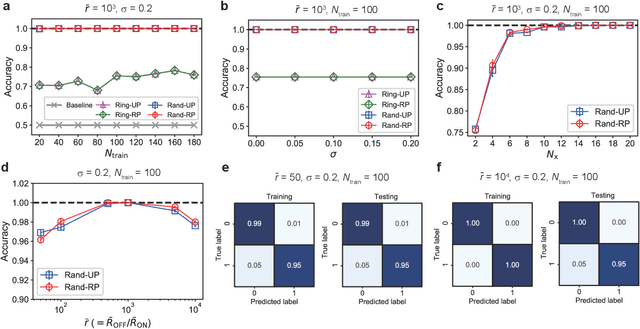Gouhei Tanaka
Symplectic Reservoir Representation of Legendre Dynamics
Dec 22, 2025Abstract:Modern learning systems act on internal representations of data, yet how these representations encode underlying physical or statistical structure is often left implicit. In physics, conservation laws of Hamiltonian systems such as symplecticity guarantee long-term stability, and recent work has begun to hard-wire such constraints into learning models at the loss or output level. Here we ask a different question: what would it mean for the representation itself to obey a symplectic conservation law in the sense of Hamiltonian mechanics? We express this symplectic constraint through Legendre duality: the pairing between primal and dual parameters, which becomes the structure that the representation must preserve. We formalize Legendre dynamics as stochastic processes whose trajectories remain on Legendre graphs, so that the evolving primal-dual parameters stay Legendre dual. We show that this class includes linear time-invariant Gaussian process regression and Ornstein-Uhlenbeck dynamics. Geometrically, we prove that the maps that preserve all Legendre graphs are exactly symplectomorphisms of cotangent bundles of the form "cotangent lift of a base diffeomorphism followed by an exact fibre translation". Dynamically, this characterization leads to the design of a Symplectic Reservoir (SR), a reservoir-computing architecture that is a special case of recurrent neural network and whose recurrent core is generated by Hamiltonian systems that are at most linear in the momentum. Our main theorem shows that every SR update has this normal form and therefore transports Legendre graphs to Legendre graphs, preserving Legendre duality at each time step. Overall, SR implements a geometrically constrained, Legendre-preserving representation map, injecting symplectic geometry and Hamiltonian mechanics directly at the representational level.
Reservoir Predictive Path Integral Control for Unknown Nonlinear Dynamics
Sep 04, 2025Abstract:Neural networks capable of approximating complex nonlinearities have found extensive application in data-driven control of nonlinear dynamical systems. However, fast online identification and control of unknown dynamics remain central challenges. This paper integrates echo-state networks (ESNs) -- reservoir computing models implemented with recurrent neural networks -- and model predictive path integral (MPPI) control -- sampling-based variants of model predictive control -- to meet these challenges. The proposed reservoir predictive path integral (RPPI) enables fast learning of nonlinear dynamics with ESN and exploits the learned nonlinearities directly in parallelized MPPI control computation without linearization approximations. The framework is further extended to uncertainty-aware RPPI (URPPI), which leverages ESN uncertainty to balance exploration and exploitation: exploratory inputs dominate during early learning, while exploitative inputs prevail as model confidence grows. Experiments on controlling the Duffing oscillator and four-tank systems demonstrate that URPPI improves control performance, reducing control costs by up to 60% compared to traditional quadratic programming-based model predictive control methods.
Structuring Multiple Simple Cycle Reservoirs with Particle Swarm Optimization
Apr 06, 2025Abstract:Reservoir Computing (RC) is a time-efficient computational paradigm derived from Recurrent Neural Networks (RNNs). The Simple Cycle Reservoir (SCR) is an RC model that stands out for its minimalistic design, offering extremely low construction complexity and proven capability of universally approximating time-invariant causal fading memory filters, even in the linear dynamics regime. This paper introduces Multiple Simple Cycle Reservoirs (MSCRs), a multi-reservoir framework that extends Echo State Networks (ESNs) by replacing a single large reservoir with multiple interconnected SCRs. We demonstrate that optimizing MSCR using Particle Swarm Optimization (PSO) outperforms existing multi-reservoir models, achieving competitive predictive performance with a lower-dimensional state space. By modeling interconnections as a weighted Directed Acyclic Graph (DAG), our approach enables flexible, task-specific network topology adaptation. Numerical simulations on three benchmark time-series prediction tasks confirm these advantages over rival algorithms. These findings highlight the potential of MSCR-PSO as a promising framework for optimizing multi-reservoir systems, providing a foundation for further advancements and applications of interconnected SCRs for developing efficient AI devices.
Federated Learning with Reservoir State Analysis for Time Series Anomaly Detection
Feb 08, 2025



Abstract:With a growing data privacy concern, federated learning has emerged as a promising framework to train machine learning models without sharing locally distributed data. In federated learning, local model training by multiple clients and model integration by a server are repeated only through model parameter sharing. Most existing federated learning methods assume training deep learning models, which are often computationally demanding. To deal with this issue, we propose federated learning methods with reservoir state analysis to seek computational efficiency and data privacy protection simultaneously. Specifically, our method relies on Mahalanobis Distance of Reservoir States (MD-RS) method targeting time series anomaly detection, which learns a distribution of reservoir states for normal inputs and detects anomalies based on a deviation from the learned distribution. Iterative updating of statistical parameters in the MD-RS enables incremental federated learning (IncFed MD-RS). We evaluate the performance of IncFed MD-RS using benchmark datasets for time series anomaly detection. The results show that IncFed MD-RS outperforms other federated learning methods with deep learning and reservoir computing models particularly when clients' data are relatively short and heterogeneous. We demonstrate that IncFed MD-RS is robust against reduced sample data compared to other methods. We also show that the computational cost of IncFed MD-RS can be reduced by subsampling from the reservoir states without performance degradation. The proposed method is beneficial especially in anomaly detection applications where computational efficiency, algorithm simplicity, and low communication cost are required.
Predicting unobserved climate time series data at distant areas via spatial correlation using reservoir computing
Jun 05, 2024Abstract:Collecting time series data spatially distributed in many locations is often important for analyzing climate change and its impacts on ecosystems. However, comprehensive spatial data collection is not always feasible, requiring us to predict climate variables at some locations. This study focuses on a prediction of climatic elements, specifically near-surface temperature and pressure, at a target location apart from a data observation point. Our approach uses two prediction methods: reservoir computing (RC), known as a machine learning framework with low computational requirements, and vector autoregression models (VAR), recognized as a statistical method for analyzing time series data. Our results show that the accuracy of the predictions degrades with the distance between the observation and target locations. We quantitatively estimate the distance in which effective predictions are possible. We also find that in the context of climate data, a geographical distance is associated with data correlation, and a strong data correlation significantly improves the prediction accuracy with RC. In particular, RC outperforms VAR in predicting highly correlated data within the predictive range. These findings suggest that machine learning-based methods can be used more effectively to predict climatic elements in remote locations by assessing the distance to them from the data observation point in advance. Our study on low-cost and accurate prediction of climate variables has significant value for climate change strategies.
Diffusion model for relational inference
Jan 30, 2024



Abstract:Dynamical behaviors of complex interacting systems, including brain activities, financial price movements, and physical collective phenomena, are associated with underlying interactions between the system's components. The issue of uncovering interaction relations in such systems using observable dynamics is called relational inference. In this study, we propose a Diffusion model for Relational Inference (DiffRI), inspired by a self-supervised method for probabilistic time series imputation. DiffRI learns to infer the probability of the presence of connections between components through conditional diffusion modeling. Experiments on both simulated and quasi-real datasets show that DiffRI is highly competent compared with other state-of-the-art models in discovering ground truth interactions in an unsupervised manner. Our code will be made public soon.
Backbone-based Dynamic Graph Spatio-Temporal Network for Epidemic Forecasting
Dec 01, 2023



Abstract:Accurate epidemic forecasting is a critical task in controlling disease transmission. Many deep learning-based models focus only on static or dynamic graphs when constructing spatial information, ignoring their relationship. Additionally, these models often rely on recurrent structures, which can lead to error accumulation and computational time consumption. To address the aforementioned problems, we propose a novel model called Backbone-based Dynamic Graph Spatio-Temporal Network (BDGSTN). Intuitively, the continuous and smooth changes in graph structure, make adjacent graph structures share a basic pattern. To capture this property, we use adaptive methods to generate static backbone graphs containing the primary information and temporal models to generate dynamic temporal graphs of epidemic data, fusing them to generate a backbone-based dynamic graph. To overcome potential limitations associated with recurrent structures, we introduce a linear model DLinear to handle temporal dependencies and combine it with dynamic graph convolution for epidemic forecasting. Extensive experiments on two datasets demonstrate that BDGSTN outperforms baseline models and ablation comparison further verifies the effectiveness of model components. Furthermore, we analyze and measure the significance of backbone and temporal graphs by using information metrics from different aspects. Finally, we compare model parameter volume and training time to confirm the superior complexity and efficiency of BDGSTN.
Dynamical Graph Echo State Networks with Snapshot Merging for Dissemination Process Classification
Jul 03, 2023



Abstract:The Dissemination Process Classification (DPC) is a popular application of temporal graph classification. The aim of DPC is to classify different spreading patterns of information or pestilence within a community represented by discrete-time temporal graphs. Recently, a reservoir computing-based model named Dynamical Graph Echo State Network (DynGESN) has been proposed for processing temporal graphs with relatively high effectiveness and low computational costs. In this study, we propose a novel model which combines a novel data augmentation strategy called snapshot merging with the DynGESN for dealing with DPC tasks. In our model, the snapshot merging strategy is designed for forming new snapshots by merging neighboring snapshots over time, and then multiple reservoir encoders are set for capturing spatiotemporal features from merged snapshots. After those, the logistic regression is adopted for decoding the sum-pooled embeddings into the classification results. Experimental results on six benchmark DPC datasets show that our proposed model has better classification performances than the DynGESN and several kernel-based models.
Simulation platform for pattern recognition based on reservoir computing with memristor networks
Dec 01, 2021



Abstract:Memristive systems and devices are potentially available for implementing reservoir computing (RC) systems applied to pattern recognition. However, the computational ability of memristive RC systems depends on intertwined factors such as system architectures and physical properties of memristive elements, which complicates identifying the key factor for system performance. Here we develop a simulation platform for RC with memristor device networks, which enables testing different system designs for performance improvement. Numerical simulations show that the memristor-network-based RC systems can yield high computational performance comparable to that of state-of-the-art methods in three time series classification tasks. We demonstrate that the excellent and robust computation under device-to-device variability can be achieved by appropriately setting network structures, nonlinearity of memristors, and pre/post-processing, which increases the potential for reliable computation with unreliable component devices. Our results contribute to an establishment of a design guide for memristive reservoirs toward a realization of energy-efficient machine learning hardware.
Reservoir Computing with Diverse Timescales for Prediction of Multiscale Dynamics
Aug 21, 2021



Abstract:Machine learning approaches have recently been leveraged as a substitute or an aid for physical/mathematical modeling approaches to dynamical systems. To develop an efficient machine learning method dedicated to modeling and prediction of multiscale dynamics, we propose a reservoir computing model with diverse timescales by using a recurrent network of heterogeneous leaky integrator neurons. In prediction tasks with fast-slow chaotic dynamical systems including a large gap in timescales of their subsystems dynamics, we demonstrate that the proposed model has a higher potential than the existing standard model and yields a performance comparable to the best one of the standard model even without an optimization of the leak rate parameter. Our analysis reveals that the timescales required for producing each component of target dynamics are appropriately and flexibly selected from the reservoir dynamics by model training.
 Add to Chrome
Add to Chrome Add to Firefox
Add to Firefox Add to Edge
Add to Edge